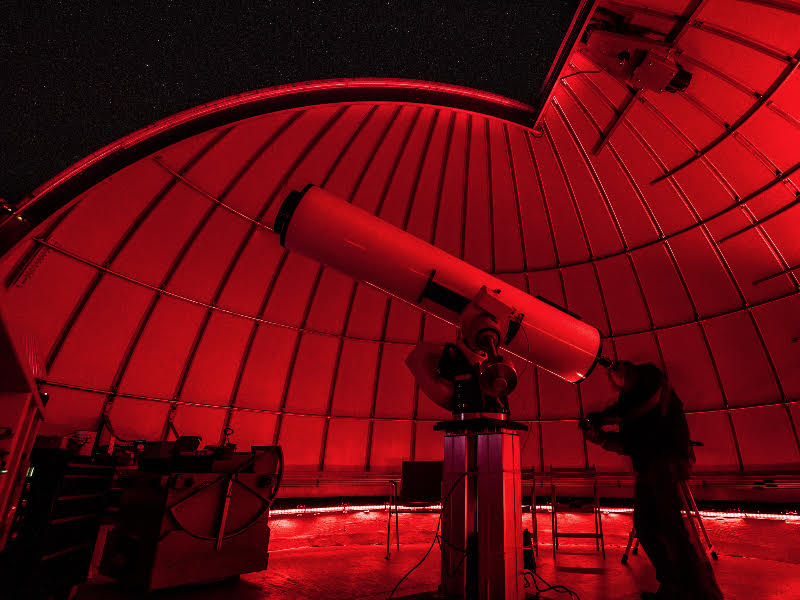Custer Institute in Southold Lists 2023 Meteor Showers & Supermoons

On a typical Saturday evening, more than 100 people visit the Custer Institute and Observatory in Southold to stargaze while enjoying the camaraderie of other astronomy enthusiasts.
The Custer Institute is located under some of the darkest skies on Long Island, affording excellent views of the Milky Way Galaxy on a clear night. Open on Saturday evenings throughout the year, the facility draws families, groups and individuals of all ages, including members of other astronomy clubs, mostly from Long Island and New York City.
“Our Saturday evening operations are informal and fluid, accommodating guests as they arrive,” says Alan Cousins, vice president of the nonprofit organization, which was founded in 1927, making it the Island’s oldest public observatory. “We usually start off with an informal tour and discuss the history of our organization and the facility. We then take visitors in groups up to the dome on the third floor for stargazing, weather permitting.”
The three-story building, which includes an exhibit area and a library, is capped with a dome that features two high-power telescopes. One is used for visual observing while the other projects the images that are seen onto a computer screen, for viewing both in the dome and elsewhere in the building. The Custer Institute has a considerable collection of telescopes and, on many Saturdays, will set up additional telescopes on the grounds. And on most Saturday evenings, viewing is also available at a smaller dome on the property that is maintained by the Amateur Observers Society of New York, another astronomy organization.
Clear nights tend to attract bigger crowds, as do summer weekends and other times of the year when many people are out east. On various Saturdays throughout the year, the Custer Institute offers special events, including concerts and lectures. Special evenings are also planned around astronomical events that happen to fall on a Saturday.
“This year, we’ll have a special evening for the Perseid meteor shower, among others,” says Anne Spooner, president of the Custer Institute. The Perseid meteor shower event on August 12 will include a performance by Aquebogue-based musician and composer Cliff Baldwin. Observatory staff will provide guided tours of the night sky, both at the dome and on telescopes set up on the grounds, while the meteor showers can also be viewed with the naked eye or binoculars.
“People can bring blankets and chaise lounges and sit and lie out and enjoy the meteor shower,” says Cousins, noting the Perseid shower is expected to be great since it will take place during a new moon, when the sky is at its darkest. But despite the favorable moon cycle, viewing also depends on the weather. “Rain showers will prevent you from watching meteor showers,” he notes.
Several other meteor showers will take place throughout the year; keep reading for more information on these and other astronomical events.
Upcoming musical performances at the Custer Institute will include the Rites of Spring Music Festival on May 27 and a concert by Gene Casey & the Lone Sharks on July 15. A lecture titled “Exploring and Navigating the Summer Night Sky” is set for June 24. The Custer Institute’s Randall DiGiuseppe will discuss how to find your way around the night sky as well as the locations and folklore behind the most prominent constellations of summer.
The Custer Institute, which is staffed entirely by volunteers, is open on Saturdays from 7 p.m. to midnight, except for Memorial Day through Labor Day, when it opens at 8 p.m., since it gets dark later. Reservations are not required, and the suggested donation for most nights is $5 for adults and $3 for kids under 12. Some special events, including concerts, have additional fees.
METEOR SHOWERS, SUPERMOONS & AN ECLIPSE, OH MY
This year will include many interesting astronomical events that do not require a telescope for viewing, according to Alan Cousins, vice president of the Custer Institute.
Meteor Showers
The following upcoming meteor showers are best observed from a dark-sky site, away from local neighborhood light pollution.
May 5–6: Eta Aquarid meteor shower (bright moon will make it hard to see)
July 29–30: Delta Aquarid meteor shower (bright moon will make it hard to see)
Aug. 12–13: Perseid meteor shower (predicted to be great)
Oct. 8–9: Draconid meteor shower
Oct. 20–21: Orionid meteor shower
Nov. 4–5: Taurid meteor shower
Nov. 17–18: Leonid meteor shower
Dec. 13–14: Geminid meteor shower (predicted to be great)
Dec. 23: Ursid meteor shower (bright moon will make it hard to see)
Supermoons
This year will include four supermoons (when the moon is closer to Earth and appears larger than usual): July 3, Aug. 1, Aug. 31 and Sept. 29
Annular Solar Eclipse
On Oct. 14, there will be an annular solar eclipse, with the moon covering about 30% of the sun as viewed from Long Island. It will begin at about 12:10 p.m., reach maximum at about 1:19 p.m., and end about 2:29 p.m. Note: Solar-safe eye protection is required!
1115 Main Bayview Road, Southold. 631-765-2626; custerobservatory.org



